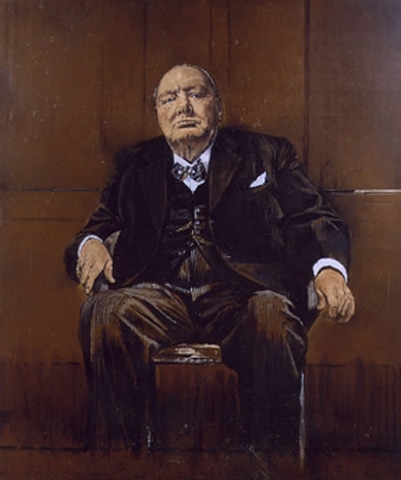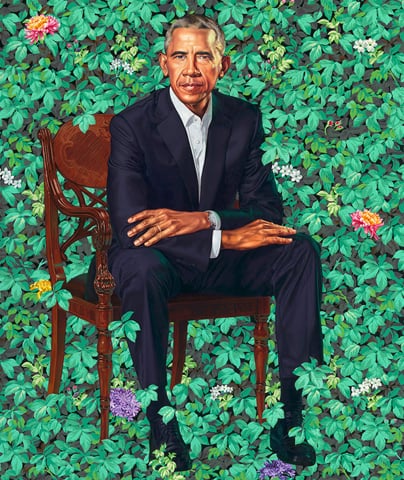
The venerable tradition of painting official portraits is well past its glory days but official representations of leaders still tend to be in the most traditional of forms — oil paintings on canvas in gilded frames, though evolving stylisations can spring surprises.
For centuries, this category of portrait painting was a flourishing art form. Painting majestic images of royalty as emblems of authority and distinction was the norm. The rise of photography dealt a blow to the painted image and today the pervasiveness of the internet and social media have rendered the medium of painting — not to mention portraiture — completely irrelevant in this regard.
Yet, painting persists and the artist-rendered authorised portrait continues to survive and be relevant as a reflection of power and privilege. There is something singular and unique about the complex inter-relationship of two people — artist and subject — that is basic to this representation. The style of the portrait — the pose, the colours, the setting, as well as facial features (in the 19th century, austere and regal was definitely the favoured expression) — all convey a measure of the sitter but who paints it and how the finished image is received decides the fate of the official portrait.
The rise of photography dealt a blow to the painted image. How changes in art, politics and the cultural environment filter into official portraits
Graham Sutherland’s famous (or infamous) portrait of Winston Churchill was commissioned in 1954 by the House of Commons to mark the former prime minister’s 80th birthday. It depicts the wartime leader scowling and slumped in a chair against a murky background. At its unveiling, Churchill sarcastically described it as “a remarkable example of modern art”, to the laughter of the assembled audience. It was supposed to hang publicly, but the government gave it to Churchill as a private gift. Lady Churchill loathed the painting and had it burned (its copies exist). Sutherland, quite understandably annoyed, described its destruction as an act of vandalism. Interestingly, Lady Churchill also admitted that Sutherland had captured Churchill’s likeness, saying it was “really quite alarmingly like him.”

Similarly, when artist Lucian Freud painted Queen Elizabeth in 2001, the portrait was so controversial that newspapers called it a “travesty.” Painted in Freud’s raw, acrid style, the monarch’s expression is cold, contorted and harsh. The director of the National Portrait Gallery called the work a small head-and-shoulders view of a pensive and rather cross face under a stupendous diamond tiara, “Thought-provoking and psychologically penetrating contribution to royal iconography which they would be delighted to hang.” However, The Daily Telegraph termed it “extremely unflattering.”
How the official portrait signifies the status and attainments of the person illustrated is well-depicted in the Mughal miniatures. Emperor Jahangir took his connoisseurship of art very seriously. Paintings created under his reign were closely catalogued, dated and even signed, providing scholars with fairly accurate ideas as to when and in what context many of the pieces were created, in addition to their aesthetic qualities. The father-son relationship and transfer of power is shown in ‘Jahangir with Portrait Of Akbar (1614)’, where Akbar’s son Jahangir gazes at a portrait of his father, who symbolically offers him the world as mentioned in The Mughal Emperors written by Francis Robinson.

If an artist has doubts about the credibility of the subject, it inevitably spills forth in the painting in a subtle or clandestine manner. Nelson Shanks who has painted Princess Diana, Pope John Paul II and others, said President Clinton’s personality was among the hardest he’s had to capture in a portrait and his 2006 portrait of Clinton was controversial. In a 2015 interview, Shanks revealed that he painted Clinton in the shadow of a blue dress as a reference to the Monica Lewinsky scandal and added the Clintons “hate the portrait.”
Should the artist give his honest opinion or should he try to play to the gallery? Should the viewer judge the portrait from their personal perspective or see it through the artist’s lens or prevalent public perception? This dilemma surrounds the numerous painted images we have of Quaid-i-Azam Muhammed Ali Jinnah. There is no verified evidence that he ever sat for an official portrait in the brief period that he was head of state. Fortunately, his archives contain some excellent photographs that do justice to his personality. Most of the portraits in circulation are sourced from these references but opinions remain divided on which one truly encapsulates the multiple facets of his distinguished persona.

Currently the buzz surrounding Kehinde Wiley and Amy Sherald’s official portraits of Barack and Michelle Obama indicates how changes in art, politics and the cultural environment filter into official portraits. Ever since the works were unveiled in February 2018, attendance numbers at Washington D.C.’s National Portrait Gallery have exploded. Audiences are curious about the Obamas’ unusual selection of artists and subsequent production of two very unusual official portraits. The Los Angeles Times wrote that both portraits “cheerfully bucked the trend” of “forgettable” recent portraits while the Guardian feels this portrait of Barack Obama “will not tell the future ages what made him special.” Eventually, the official portrait is for posterity. The figure in history is what matters.
Published in Dawn, EOS, September 23rd, 2018















































Dear visitor, the comments section is undergoing an overhaul and will return soon.